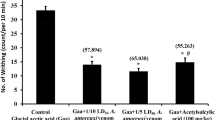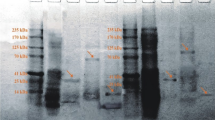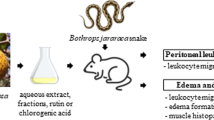Abstract
Stings from the wasp Parachartergus fraternus occur throughout Latin America, and edema followed by pain is the main symptom presented by victims. This often limited inflammatory event has not been characterized for this species. In this work, we identified the mechanisms and possible mediators involved in this response. P. fraternus venom (100, 200, and 400 μg/kg) was injected into the hind paws of mice, and edema was evaluated at intervals of 10 min for up to 60 min and at 120, 240, and 1440 min using a digital plethysmometer. The peak of edema was observed at 10 min with a dose of 200 μg/kg. A reduction in edema was observed with indomethacin (58.1%), celecoxib (44.5%), MK886 (30.8%), and dexamethasone (53.2%). Loratadine, cimetidine, and cyproheptadine treatment reduced the edema by 54.2%, 63.9%, and 84.4%, respectively, compared with the control. Captopril and l-NAME inhibited 42.5% and 69.8%, respectively, of the edema. These results showed that the edema induced in mice by P. fraternus venom occurs early and is mediated by arachidonic acid derivatives, vasoactive amines, and nitric oxide. Together, these mediators amplify the inflammatory process, with emphasis on histamine and serotonin in triggering the edematogenic response, being more effective the use of cyproheptadine in the therapeutic approach.



Similar content being viewed by others
References
Carpenter, J.M., and O.M. Marques. 2001. Contribuição ao estudo dos vespídeos do Brasil. Bahia: UFB.
Somavilla, A., and M.L. Oliveira. 2017. Social wasps (Vespidae: Polistinae) from an Amazon rainforest fragment: Ducke Reserve. Sociobiology. 64: 125. https://doi.org/10.13102/sociobiology.v64i1.1215.
Edery, H., J. Ishay, S. Gitter, and H. Joshua. 2013. Venoms of vespidae. In Arthropod venoms, ed. S. Bettini, 691–771. New York: Springer-Verlag Berlin Heidelberg.
Umakanth, M. 2017. Acute pancreatitis following multiple wasps stung. Saudi Journal of Medical and Pharmaceutical Sciences 3: 441–443.
Forrester, J.A., T.G. Weiser, and J.D. Forrester. 2018. An update on fatalities due to venomous and nonvenomous animals in the United States (2008–2015). Wilderness & Environmental Medicine 29: 36–44. https://doi.org/10.1016/j.wem.2017.10.004.
Richards, O.W. 1978. Social wasps of America excluding the Vespinae. London: British Museum Press.
Olson, E.J. 2000. Parachartergus fraternus (Gribodo) (Hymenoptera: Vespidae: Polistinae) uses venom when taking caterpillar prey. Psyche. 103: 85–93. https://doi.org/10.1155/2000/62738.
Mateus, S. 2011. Observations on forced colony emigration in Parachartergus fraternus (Hymenoptera: Vespidae: Epiponini): new nest site marked with sprayed venom. Psyche. 2011: 1–8. https://doi.org/10.1155/2011/157149.
Nakajima, T. 1986. Pharmacological biochemistry of vespid venoms. In Venoms of the Hymenoptera: biochemical, pharmacological and behavioural aspects, ed. T. Piek, 309–327. London: Academic Press.
Fitzgerald, K.T., and A.A. Flood. 2006. Hymenoptera stings. Clinical Techniques in Small Animal Practice 21: 194–204. https://doi.org/10.1053/j.ctsap.2006.10.002.
Mortari, M.R., L.L. Couto, L.A. Carneiro, C.B.F. Mourao, T.S. Camargo, J.A.G. Vargas, F.N. Oliveira, C.D.C. Gati, C.A. Schwartz, and E.F. Schwartz. 2012. Pharmacological characterization of Synoeca cyanea venom: an aggressive social wasp widely distributed in the Neotropical region. Toxicon. 59: 163–170. https://doi.org/10.1016/j.toxicon.2011.11.002.
Winter, C.A., E.A. Risley, and G.W. Nuss. 1962. Carrageenin-induced edema in hind paw of the rat as an assay for anti-inflammatory drugs. Proceedings of the Society for Experimental Biology and Medicine 111: 544–547.
Albuquerque, T.M., N.M. Alencar, J.G. Figueiredo, I.S. Figueiredo, C.M. Teixeira, F.S. Bitencourt, D.D. Secco, E.F. Araújo, A.M. Leão, and M.V. Ramos. 2009. Vascular permeability, neutrophil migration and edematogenic effects induced by the latex of Cryptostegia grandiflora. Toxicon. 53: 15–23. https://doi.org/10.1016/j.toxicon.2008.10.009.
Barbosa, A.M., R.O. Amaral, C.F.P. Teixeira, S. Hyslop, and J.C. Cogo. 2003. Pharmacological characterization of mouse hind paw oedema induced by Bothrops insularis (jararaca ilhoa) snake venom. Toxicon. 42: 515–523. https://doi.org/10.1016/S0041-0101(03)00230-7.
Lopes, P.H., M.M.T. Rocha, A.K. Kuniyoshi, F.C.V. Portaro, and L.R.C. Gonçalves. 2017. Edema and nociception induced by Philodryas patagoniensis venom in mice: a pharmacological evaluation with implications for the accident treatment. The Journal of Pharmacology and Experimental Therapeutics. 361: 349–354. https://doi.org/10.1124/jpet.116.239640.
Paula, L., W.G. Santos, A. Malheiro, D. Carlos, and L.H. Faccioli. 2006. Differential modulation of cell recruitment and acute edema in a model of Polybia paulista venom-induced inflammation. International Immunopharmacology 6: 182–189. https://doi.org/10.1016/j.intimp.2005.08.002.
Sharma, J.N., A.M. Samud, and M.Z. Asmawi. 2004. Comparison between plethysmometer and micrometer methods to measure acute paw oedema for screening anti-inflammatory activity in mice. Inflammopharmacology. 12: 89–94. https://doi.org/10.1163/156856004773121400.
Shivkar, Y.M., and V.L. Kumar. 2003. Histamine mediates the proinflammatory effect of latex of Calotropis procera in rats. Mediators of Inflammation 12: 299–302. https://doi.org/10.1080/096293503310001619708.
Toni, L.G.B., D.L. Menaldo, A.C.O. Cintra, M.J. Figueiredo, A.R. Souza, W.M.A. Maximiano, M.C. Jamur, G.E.P. Souza, and S.V. Sampaio. 2015. Inflammatory mediators involved in the paw edema and hyperalgesia induced by Batroxase, a metalloproteinase isolated from Bothrops atrox snake venom. International Immunopharmacology 28: 199–207. https://doi.org/10.1016/j.intimp.2015.06.001.
Wanderley, C.W.S., C.M.S. Silva, D.V.T. Wong, R.M. Ximenes, D.F.C. Morelo, F. Cosker, K.S. Aragão, C. Fernandes, R.C. Palheta-Júnior, A. Havt, G.A.C. Brito, F.Q. Cunha, R.A. Ribeiro, and R.C.P. Lima-Júnior. 2014. Bothrops jararacussu snake venom-induces a local inflammatory response in a prostanoid- and neutrophil-dependent manner. Toxicon. 90: 134–147. https://doi.org/10.1016/j.toxicon.2014.08.001.
Witharana, E.W.R.A., S.K.J. Wijesinghe, K.S.M. Pradeepa, W.A.I.P. Karunaratne, and S. 2015. Bee and wasp stings in Deniyaya; a series of 322 cases. The Ceylon Medical Journal 60: 5–9. https://doi.org/10.4038/cmj.v60i1.7406.
Mortari, M.R., A.O.S. Cunha, O. Oliveira, E.A. Gelfuso, E.B. Vieira, and W.F. Santos. 2005. Comparative toxic effects of the venoms from three wasp species of the genus Polybia (Hymenoptera, Vespidae). Journal of Biological Sciences 5: 449–454.
Yshii, L.M., G.H.M.F. Souza, E.A. Camargo, M.N. Eberlin, M.T.C.P. Ribela, M.N. Muscara, S. Hyslop, and S.K.P. Costa. 2009. Characterization of the mechanisms underlying the inflammatory response to Polistes lanio lanio (paper wasp) venom in mouse dorsal skin. Toxicon. 53: 42–52. https://doi.org/10.1016/j.toxicon.2008.10.006.
Eno, A.E. 1997. Pharmacological investigation of oedema induced by venom from the wasp Polistes fuscatus. Toxicon 35: 1691–1698.
Dias, N.B., B.M. Souza, P.C. Gomes, P. Brigatte, and M.S. Palma. 2015. Peptidome profiling of venom from the social wasp Polybia paulista. Toxicon. 107: 290–303. https://doi.org/10.1016/j.toxicon.2015.08.013.
Gonçalves, J., M. Rangel, A. Biolchi, E. Alves, K. Moreira, L. Silva, and M. Mortari. 2016. Antinociceptive properties of the mastoparan peptide Agelaia-MPI isolated from social wasps. Toxicon. 120: 15–21. https://doi.org/10.1016/j.toxicon.2016.07.009.
Mendes, M.A., B.M. Souza, and M.S. Palma. 2005. Structural and biological characterization of three novel mastoparan peptides from the venom of the neotropical social wasp Protopolybia exigua (Saussure). Toxicon. 45: 101–106. https://doi.org/10.1016/j.toxicon.2004.09.015.
Griesbacher, T., P. Althuber, M. Zenz, I. Rainer, S. Griengl, and F. Lembeck. 1998. Vespula vulgaris venom: role of kinins and release of 5-hydroxytryptamine from skin mast cells. European Journal of Pharmacology 351: 95–104. https://doi.org/10.1016/S0014-2999(98)00276-3.
Khanapure, S.P., D.S. Garvey, D.R. Janero, and L.G. Letts. 2007. Eicosanoids in inflammation: biosynthesis, pharmacology, and therapeutic frontiers. Current Topics in Medicinal Chemistry 7: 311–340.
Morimoto, K., N. Shirata, Y. Taketomi, S. Tsuchiya, E. Segi-Nishida, T. Inazumi, K. Kabashima, S. Tanaka, M. Murakami, X.S. Narumiya, and Y. Sugimoto. 2014. Prostaglandin E2–EP3 signaling induces inflammatory swelling by mast cell activation. Journal of Immunology 192: 1130–1137. https://doi.org/10.4049/jimmunol.1300290.
Olivo, R.A., C.F.P. Teixeira, J.L. Wallace, J.M. Gutierrez, and S.R. Zamuner. 2007. Role of cyclooxygenases in oedema-forming activity of bothropic venoms. Toxicon. 49: 670–677. https://doi.org/10.1016/j.toxicon.2006.11.006.
Toriyabe, M., K. Omote, T. Kawamata, and A. Namiki. 2004. Contribution of interaction between nitric oxide and cyclooxygenases to the production of prostaglandins in carrageenan-induced inflammation. Anesthesiology 101: 983–990.
King, T.P., S.Y. Jim, and K.M. Wittkowski. 2003. Inflammatory role of two venom components of yellow jackets (Vespula vulgaris): a mast cell degranulating peptide mastoparan and phospholipase A1. International Archives of Allergy and Immunology 131: 25–32. https://doi.org/10.1159/000070431.
Rao, N.L., P.J. Dunford, X. Xue, X. Jiang, K.A. Lundeen, F. Coles, J.P. Riley, K.N. Williams, C.A. Grice, J.P. Edwards, L. Karlsson, and A.M. Fourie. 2007. Anti-inflammatory activity of a potent, selective leukotriene A4 hydrolase inhibitor in comparison with the 5-lipoxygenase inhibitor zileuton. The Journal of Pharmacology and Experimental Therapeutics 321: 1154–1160. https://doi.org/10.1124/jpet.106.115436.
Sousa, P.L., Y.P. Quinet, L.A.C. Brizeno, T.L. Sampaio, A.F.C. Torres, A.M.C. Martins, and A.M.S. Assreuy. 2016. The acute inflammatory response induced in mice by the venom of the giant ant Dinoponera quadriceps involves macrophage and interleukin-1 β. Toxicon. 117: 22–29. https://doi.org/10.1016/j.toxicon.2016.03.009.
Tommasini, I., and O. Cantoni. 2004. Dexamethasone promotes toxicity in U937 cells exposed to otherwise nontoxic concentrations of peroxynitrite: pivotal role for lipocortin 1-mediated inhibition of cytosolic phospholipase A2. Molecular Pharmacology 65: 964–972. https://doi.org/10.1124/mol.65.4.964.
Hall, S.E., S. Lim, I.R. Witherden, T.D. Tetley, P.J. Barnes, A.M. Kamal, and S.F. Smith. 1999. Lung type II cell and macrophage annexin I release: differential effects of two glucocorticoids. The American Journal of Physiology 276: L114–L121. https://doi.org/10.1152/ajplung.1999.276.1.L114.
Bartko, J., L. Stiebellehner, U. Derhaschnig, C. Schoergenhofer, M. Schwameis, H. Prosch, and B. Jilma. 2016. Dissociation between systemic and pulmonary anti-inflammatory effects of dexamethasone in humans. British Journal of Clinical Pharmacology 81: 865–877. https://doi.org/10.1111/bcp.12857.
Al-Harbi, N.O., F. Imam, M.M. Al-Harbi, M.A. Ansari, K.M. Zoheir, H.M. Korashy, M.M. Sayed-Ahmed, S.M. Attia, O.A. Shabanah, and S.F. Ahamad. 2016. Dexamethasone attenuates LPS-induced acute lung injury through inhibition of NF-κB, COX-2, and pro-inflammatory mediators. Immunological Investigations 45: 349–369. https://doi.org/10.3109/08820139.2016.1157814.
Oropeza, A.R., S. Mikkelsen, C. Bindslev-Jensen, and C.G. Mortz. 2017. Pre-hospital treatment of bee and wasp induced anaphylactic reactions: a retrospective study. Scandinavian Journal of Trauma, Resuscitation and Emergency Medicine 25: 4. https://doi.org/10.1186/s13049-016-0344-y.
Calixto, M.C., K.M. Trichês, and J.B. Calixto. 2003. Analysis of the inflammatory response in the rat paw caused by the venom of Apis melifera bee. Inflammation Research 52: 132–139.
Medzhitov, R. 2008. Origin and physiological roles of inflammation. Nature. 454: 428–435. https://doi.org/10.1038/nature07201.
Tiligada, E., and M. Ennis. 2018. Histamine pharmacology: from Sir Henry Dale to the 21st century. British Journal of Pharmacology. https://doi.org/10.1111/bph.14524.
Lamraoui, A., S. Adi-Bessalem, and F. Laraba-Djebari. 2014. Modulation of tissue inflammatory response by histamine receptors in scorpion envenomation pathogenesis: involvement of H4 receptor. Inflammation. 37: 1689–1704. https://doi.org/10.1007/s10753-014-9898-x.
Welsh, A.L., and M. Ede. 1962. Further studies of cyproheptadine as an antiallergic, antipruritic agent. The Journal of New Drugs 2: 88–93.
Wernersson, S., and G. Pejler. 2014. Mast cell secretory granules: armed for battle. Nature Reviews. Immunology 14: 478–494. https://doi.org/10.1038/nri3690.
Decarie, A., A. Adam, and J. Couture. 1996. Effects of captopril and icatibant on bradykinin (BK) and des[Arg9]BK in carrageenan-induced edema. Peptides 17: 1009–1015.
Lim, H.W., R. Kamide, and I. Gigli. 1984. Effect of captopril on the vascular permeability changes induced by C5a, histamine and compound 48/80. British Journal of Dermatology 112: 43–45.
Sun, N., L. Zhai, H. Li, L. Shia, Z. Yao, and B. Zhang. 2016. Angiotensin-converting enzyme inhibitor (ACEI)-mediated amelioration in renal fibrosis involves suppression of mast cell degranulation. Kidney & Blood Pressure Research 41: 108–118. https://doi.org/10.1159/000368549.
Sebia-Amrane, F., and F. Laraba-Djebari. 2013. Pharmaco-modulations of induced edema and vascular permeability changes by Vipera lebetina venom: inflammatory mechanisms. Inflammation. 36: 434–443. https://doi.org/10.1007/s10753-012-9563-1.
Laurindo, F.R.M., M. Liberman, D.C. Fernandes, and P.F. Leite. 2018. Endothelium-dependent vasodilation: nitric oxide and other mediators. In Endothelium and cardiovascular diseases: vascular biology and clinical syndromes, ed. P.L. Luz, P. Libby, F.R.M. Laurindo, and A.C.P. Chagas, 97–113. London: Academic Press.
Acknowledgments
Acknowledgment is given to Andreia Biolchi Mayer for the assistance in the collection of the P. fraternus specimens.
Funding
This study was funded by the Federal University of Mato Grosso do Sul and Coordenação de Aperfeiçoamento de Pessoal de Nível Superior (CAPES)—Finance Code 001 and scholarship 1655328.
Author information
Authors and Affiliations
Corresponding author
Ethics declarations
All experiments were approved by the Ethics Committee on Animal Experimentation of the UFMS (protocol 764/2016) and were conducted in accordance with the National Institutes of Health Regulations on the Use and Care of Animals for Scientific Purposes.
Conflict of Interest
The authors declare that they have no conflict of interest.
Additional information
Publisher’s Note
Springer Nature remains neutral with regard to jurisdictional claims in published maps and institutional affiliations.
Rights and permissions
About this article
Cite this article
de Araujo Isaias Muller, J., Mortari, M.R., Moslaves, I.S.B. et al. Pharmacological Characterization of Mouse Hind Paw Edema Induced by Parachartergus fraternus Venom. Inflammation 42, 2011–2019 (2019). https://doi.org/10.1007/s10753-019-01062-6
Published:
Issue Date:
DOI: https://doi.org/10.1007/s10753-019-01062-6




